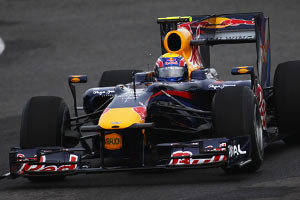mep wrote:Somehow I fail to see why you think one is for oil.
sorry there I was referring to the Renault picture in this and obviously they have separate oil coolers sitting low behind the Waterrads.
I see that the big fat tubes on top meet into one single tube near the exhaust.
So there must be the same liquid in both tubes (hot water because of the big diameter). The two lower tubes can only be the exit of the water. They have smaller diameter because the water is colder but Compared to the big inlet pipes they both need to be exit pipes for water. Simply because a lot of volume goes into radiator so a lot must go out of it - the difference due to thermal expansion.
thermal expansion of water?You will not have too much delta in and outlet temp in through the core..and the volume will increase in a range of not even 4% over a range of 0-100°C so that cannot be the reason for difference in water pipe diameter..see table:
http://de.academic.ru/pictures/dewiki/8 ... omalie.png
The radiator is split into a top and lower one. I guess the hot water will enter it on top and then will flow to the inside of the car. Then the colder will flow on the front of the radiator back to the outside of the car and into the exit pipes. The reason is because on the front the air is cold and can therefore still cool the cold water down. On the back side the air already got heated up but is still able to cool the hot water down.
the in and outlets on the same side are there for a reason. It is a double pass radiator ,this is to keep the speed of the flow high and achieve turbulent flow ,which could be better for heat transfer with the tubes they use in the core...very
hard to tell without seeing the actual part.splitting up theflows does of course the exact opposite create two rads in one.
The oil cooler is possible located on top of the gearbox. That’s why they have that massive opening at the end of their airbox.
by marcus
One more example where you can see :simply copying this mess would lead you nowhere as it is fairly obvious this happened more out of solving issues than it was originally on their plan....the lower upwards facing wateroutlet is an add on ...compare to the other very integrated solutions...I´´d guess originally they had only the top outlet but faced issues?
I also fail to see why it looks like an add on. I think we can agree that the big tubes are always inlets. So the upward pointing smaller tubes (in fact for the flow they point downwards) are always outlets.I´´m not sure if the top tubes are in or outlets .. reverse flow designs are common .
So when you have just the higher outlet its diameter will be to small compared to both big inlet tubes. So I guess you think they had just one of the big tubes.
Yes! and it is indeed siamesed very early after the bend ...so i guess the y had some issue with cooling efficiency and diverted flow to slow down cooling flows ,perhaps.
1. When you have the lower big tube water must flow uphill to get to the higher outlet. How you force the water to do so without back mixing hot and cold water?
under each and every of the beautyful welds there is vertical baffling to form the flow paths they need.So the Water tank we see is In and outlet plus these in and outlets are also completely devided. creating two separate double pass radiators in paralell ..in one assembly... quite elaborate... if they would not have the y-piece in the top tube one could think they have split up the water cooling in two circuits..but obviously it does not go that far.
2. When you have just the higher outlet and the higher inlet the lower area of the radiator will not get used efficiently.
Any comments please…..



